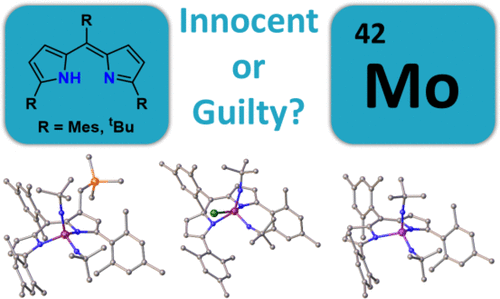当前位置:
X-MOL 学术
›
Inorg. Chem.
›
论文详情
Our official English website, www.x-mol.net, welcomes your feedback! (Note: you will need to create a separate account there.)
Molybdenum(VI) bis-imido Complexes of Dipyrromethene Ligands.
Inorganic Chemistry ( IF 4.6 ) Pub Date : 2020-07-08 , DOI: 10.1021/acs.inorgchem.0c01051 Jan Locher 1 , Fabian A Watt 1 , Adam G Neuba 1 , Roland Schoch 1 , Dominik Munz 2, 3 , Stephan Hohloch 4
Inorganic Chemistry ( IF 4.6 ) Pub Date : 2020-07-08 , DOI: 10.1021/acs.inorgchem.0c01051 Jan Locher 1 , Fabian A Watt 1 , Adam G Neuba 1 , Roland Schoch 1 , Dominik Munz 2, 3 , Stephan Hohloch 4
Affiliation

|
We report the synthesis of high-valent molybdenum(VI) bis-imido complexes 1–4 with dipyrromethene (DPM) supporting ligands of the general formula (DPMR)Mo(NR′)2Cl (R, R′ = mesityl (Mes) or tert-butyl (tBu)). The electrochemical and chemical properties of 1–4 reveal unexpected ligand noninnocence and reactivity. 15N NMR spectroscopy is used to assess the electronic properties of the imido ligands in the tert-butyl complexes 1 and 3. Complex 1 is inert toward ligand (halide) exchange with bulky phenolates such as KOMes or amides (e.g., KN(SiMe3)2), whereas the use of the lithium alkyl LiCH2SiMe3 results in a rare nucleophilic β-alkylation of the DPM ligand. While the reductions of the complexes occur at molybdenum, the oxidation is centered at the DPM ligand. Quantum-chemical calculations (complete active space self-consistent field, density functional theory) suggest facile (near-infrared) interligand charge transfer to the imido ligand, which might preclude the isolation of the oxidized complex [1]+ in the experiment.
中文翻译:

二吡咯亚甲基配体的钼(VI)双亚氨基配合物。
我们报告的高价钼(VI)合成双-酰亚胺配合物1 - 4与二吡咯亚甲基(DPM)支撑所述通式(DPM的配体- [R )的Mo(NR')2氯(R,R'=异亚丙基丙酮(MES )或叔丁基(t Bu))。的电化学和化学性质1 - 4揭示了意想不到的配体noninnocence和反应性。15 N NMR光谱用于评估叔丁基配合物1和3中亚氨基配体的电子性质。综合大楼1对大量的酚盐(例如KOMes或酰胺类,例如KN(SiMe 3)2)交换配体(卤化物)是惰性的,而使用LiCH 2烷基锂SiMe 3则导致DPM配体的罕见亲核β-烷基化。虽然复合物的还原发生在钼,但氧化集中在DPM配体上。量子化学计算(完整的活性空间自洽场,密度泛函理论)表明,容易的(近红外)配体电荷转移到亚氨基配体上,这可能会阻止实验中氧化复合物的分离[1] +。
更新日期:2020-07-20
中文翻译:

二吡咯亚甲基配体的钼(VI)双亚氨基配合物。
我们报告的高价钼(VI)合成双-酰亚胺配合物1 - 4与二吡咯亚甲基(DPM)支撑所述通式(DPM的配体- [R )的Mo(NR')2氯(R,R'=异亚丙基丙酮(MES )或叔丁基(t Bu))。的电化学和化学性质1 - 4揭示了意想不到的配体noninnocence和反应性。15 N NMR光谱用于评估叔丁基配合物1和3中亚氨基配体的电子性质。综合大楼1对大量的酚盐(例如KOMes或酰胺类,例如KN(SiMe 3)2)交换配体(卤化物)是惰性的,而使用LiCH 2烷基锂SiMe 3则导致DPM配体的罕见亲核β-烷基化。虽然复合物的还原发生在钼,但氧化集中在DPM配体上。量子化学计算(完整的活性空间自洽场,密度泛函理论)表明,容易的(近红外)配体电荷转移到亚氨基配体上,这可能会阻止实验中氧化复合物的分离[1] +。


























 京公网安备 11010802027423号
京公网安备 11010802027423号